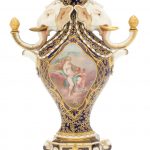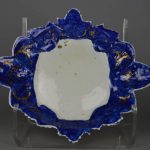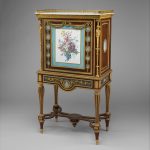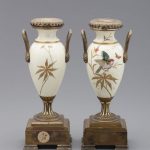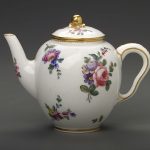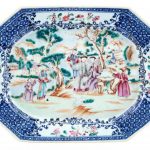Soft-paste porcelain (sometimes simply “soft paste”, or “artificial porcelain”) is a type of ceramic material in pottery, usually accepted as a type of porcelain. It is weaker than “true” hard-paste porcelain, and does not require either the high firing temperatures or the special mineral ingredients needed for that. There are many types, using a range of materials. The material originated in the attempts by many European potters to replicate hard-paste Chinese export porcelain, especially in the 18th century, and the best versions match hard-paste in whiteness and translucency, but not in strength. But the look and feel of the material can be highly attractive, and it can take painted decoration very well.
The ingredients varied considerably, but always included clay, often ball clay, and often ground glass, bone ash, soapstone (steatite), flint, and quartz. They rarely included the key ingredients necessary for hard-paste, china clay including kaolin, or the English china stone, although some manufacturers included one or other of these, but failed to get their kilns up to a hard-paste firing temperature. They were called “soft paste” (after the French “pâte tendre”) either because the material is softer in the kiln, and prone to “slump”, or their firing temperatures are lower compared with hard-paste porcelain, or, more likely, because the finished products actually are far softer than hard-paste, and early versions were much easier to scratch or break, as well as being prone to shatter when hot liquid was suddenly poured into them. Reference: Wikipedia
A Minton vase ‘à Têtes d’Eléphant’, dated 1878 Modelled after the Sèvres prototype, with elephant heads at the necks, their trunks with gilt finials at the tips, richly decorated with a blue ground covered in vermiculé gilding and reserved with a panel of Venus and Cupid, the reverse with a spray of fruit and flowers, 29.8cm high, impressed mark FOOTNOTES As part of their exercise in reproducing the soft paste porcelain of Sèvres, Minton borrowed a number of priceless original vases from the leading collections of the day, including Sir Richard Wallace and Alfred Rothschild. Minton’s artistic director, Leon Arnoux had come from Sèvres and understood its subtle beauty. He provided the workmen at Minton with the formula for soft paste porcelain used at Sèvres as he wanted Minton’s bone china to resemble the original as closely as possible. Thomas Goode was one of the collectors who lent their treasured Sèvres for copying. A similar pair of Minton Vase Duplessis à têtes d’éléphant from the Thomas Goode collection is illustrated by Joan Jones, Minton, The First 200 Years (1993), p.86. Another very similar vase in the Minton Museum Collection was sold by Bonhams, 23 July 2002, lot 84 and a pair by Bonhams on 3 June 2015, lot 22
Sold for £ 1,625 inc. premium at Bonhams in 2018
Dish; soft-paste porcelain; lozenge shaped; rim moulded as series of overlapping leaves decorated in dark underglaze-blue on which are gilt leaves, scrolls and flowers, gilt on rim and traces of gilding in well. Producer name Factory of: West Pans Porcelain Manufactory
Reference: © The Trustees of the British Museum
A Chantilly Soft-Paste Porcelain and Gilt Bronze Inkwell 18th century Height 6 1/4 inches.
Sold for $3,000 at Leslie Hindman Auctioneers in 2019
Drop-front desk (secrétaire à abattant or secrétaire en cabinet) Maker: Attributed to Adam Weisweiler (French, 1744–1820) Manufactory: Porcelain plaques made by Sèvres Manufactory (French, 1740–present)
Oak veneered with burl thuya, amaranth, mahogany, satinwood, holly, and ebonized holly; painted metal; one soft-paste porcelain plaque; fifteen jasper medallions; gilt-bronze mounts; marble; leather (not original)
Reference: The Metropolitan Museum of Art
Pair of soft-paste porcelain and ormolu vases made in France Made in France, Europe, c 1740. Pair of soft-paste, vases, cream-coloured porcelain urns mounted on square metal bases. The decoration consists of birds and butterflies in high relief iridescent enamels in red, blue and other colours.
Reference: Museum of Applied Art and Sciences
Teapot French 1774 Made at Sèvres Manufactory (France)
Soft paste porcelain decorated in colored enamels and gold. Markings Marked on base with interlaced Ls and date letter V, painter’s mark: four dots. Incised mark: BL.
Reference: Museum of Fine Arts Boston
A pair of gilt-bronze mounted bleu céleste Sèvres soft-paste porcelain pots-pourri vases and covers, the porcelain circa 1770, the mounts Louis XVI the porcelain with sprays of pink roses in gilt framed medallions, on a bleu céleste ground; (one vase broken and one cover restored) Quantity: 2 Haut. 25 cm, larg. 13,5 cm, prof. 10 cm ; Height 9 3/4 in; width 5 1/4 in; depth 4 in
Sold for 3,500 EUR at Sothebys in 2018
Figure of ‘Winter’, soft-paste porcelain, decorated in enamel colours.
Reference: © Victoria and Albert Museum
